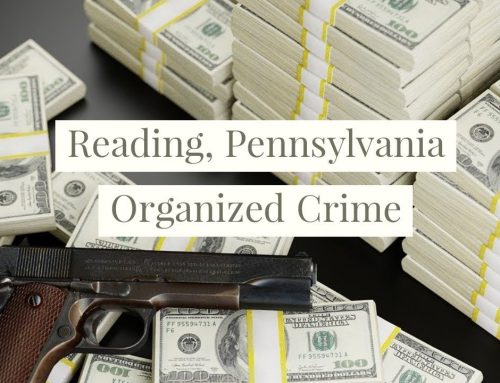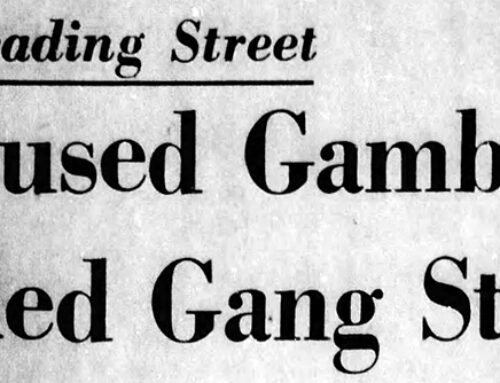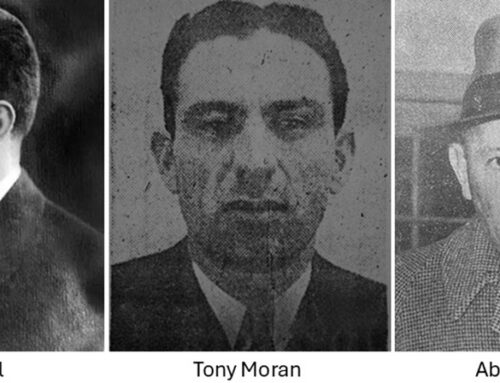In the annals of American organized crime, the names that resonate are often tied to the sprawling metropolises of New York or Chicago. Yet, in the mid-20th century, the far smaller city of Reading, Pennsylvania, earned the notorious moniker “Sin City,” largely due to the criminal empire built by one man: Abraham “Abe” Minker. Known by a host of aliases that bespoke his status—”the Baron,” “the Brain,” “the General”—Minker’s story is one of cunning ambition, systemic corruption, and the calculated manipulation of a city’s government. His reign reveals how a single, determined racketeer could transform a proud industrial town into his personal fiefdom.
From Pushcart to Prison: The Forging of a Racketeer
Abe Minker’s journey began far from the corridors of power. Born in 1898 in Brest Litovsk, Russia (now Belarus), he was part of a poor Jewish family that immigrated to the United States around 1903, eventually settling in Reading. With a father, Samuel, devoted to religious study and a mother, Ida, running a small bakery to support the family, Abe left school early to join his brothers as a huckster, selling produce from a pushcart. While his formal education was scant, he possessed a formidable, innate talent for numbers—a skill that would later underpin his entire criminal enterprise.
The arrival of Prohibition in 1920 was Minker’s call to action. He quickly graduated from selling apples to bootlegging alcohol, using his wholesale produce business at 333 North Eighth Street as a cover. He formed the “North 8th Street Gang” and engaged in high-risk ventures, including a brazen scheme to hijack his own alcohol shipments to cheat his Philadelphia mob suppliers. This act of treachery nearly cost him his life; the Philly mob dispatched a four-man squad in a Jordan touring car to abduct him from his Elm Street home. Minker escaped in a hail of gunfire, triggering a violent feud with the rival “South 7th Street Gang.” The aftermath landed him in the Eastern Penitentiary in 1922, not for bootlegging, but for perjury, after lying about his assailants in court.
The Ascent to Power: A Calculated Consolidation
After his release in 1925, Minker spent years attempting legitimate business ventures while methodically rebuilding his underworld connections. He operated in the multi-state bootlegging world of the 1930s, accumulating federal indictments and another prison sentence in Lewisburg. These years hardened him and provided him with the capital and network to dive deep into the lucrative numbers lottery racket.
The pivotal moment in Minker’s rise came in March 1945 with the murder of Reading’s reigning rackets boss, Tony Moran, who was executed in his basement gambling joint behind Cole Watson’s poolroom. The triggerman was Johnny Wittig, who insiders claimed was paid by Minker for the hit. After serving a reduced sentence, Wittig returned to Reading to become Minker’s unassailable “No. 1 guy” and chief enforcer. With Moran eliminated, Minker began a systematic consolidation of Reading’s vice operations, positioning himself as the city’s undisputed rackets kingpin.
The Baron’s Reign: An Empire Built on Vice
Minker’s influence was first exposed nationally during the 1951 U.S. Senate Kefauver Committee hearings on organized crime. While local slot machine king Ralph Kreitz charmed senators with his folksy candor, Minker and his brother Isadore were defiant, repeatedly invoking the Fifth Amendment to dodge questions about their connections to national figures like Frank Costello and Nig Rosen.
His complete takeover of the city was temporarily stalled by the “pearly gray” administration of Republican Mayor James Bamford (1952-1955), which tolerated independent operators. But Minker’s true opportunity came with the 1955 mayoral election. He heavily financed the campaign of Daniel F. McDevitt, a tavern owner whose establishment, the Reading House, was conveniently located next to Minker’s Fairmore Amusement Company.
With McDevitt in office, the floodgates of corruption opened wide. Minker’s control was absolute:
- The Pinball Shakedown: In a masterstroke of extortion disguised as civic reform, McDevitt announced a city-wide ban on multi-coin pinball machines. This was a charade to force the independent operators of the Berks County Amusement Operators Association (BCAOA) to pay “protection money.” Minker’s nephew, Alex Fudeman, served as the bagman, collecting weekly fees under the guise of “public relations” in exchange for the promise that city and county officials would look the other way. Those who resisted, like operator Chuck Schwambach, received intimidating visits from Johnny Wittig.
- The Crown Jewel—The Interstate Craps Casino: Minker provided the essential political protection for a massive, high-stakes craps casino, first located at 10th and Walnut and later on Cherry Street. Managed by Philadelphia mobster George “Skinny” Barrett, the casino was a regional attraction, with a fleet of “luggers” chauffeuring high rollers nightly from Philadelphia and New Jersey. For his services, Minker reportedly received $1,000 per week plus a percentage of the profits.
- The Numbers Racket and The White House Market: Seeking a veneer of legitimacy, Minker opened the White House Market in the early 1950s at the intersection of Route 562 and Route 422. After a fire in 1957, he rebuilt it as a supermarket, which became both his public business front and a quiet headquarters for his rackets. The market employed 20–25 people and served as a meeting place for Minker and his aides, including Wittig. A private basement “Blue Room” doubled as a conference space for daily gambling discussions. Locals even whispered about a hidden safe installed beneath his chair. Though he was outwardly a grocer, the market became synonymous with his underworld presence.

Levine”s Fabrics opened in the former White House Market building at 2801 Perkiomen Ave., Mount Penn, on Sept. 16, 1971. The earlier supermarket was owned by reputed racketeer Abe Minker.
Personality, Reputation, and Legal Battles
Minker was paradoxical: ruthless in business yet generous to friends and employees he trusted. He was known to fire subordinates for insubordination but quietly gave financial support to those in need. Chronic back trouble plagued him in his later years, yet he remained a solid presence in Reading’s underworld.
Legally, Minker fought deportation efforts in the mid-1950s when the Justice Department sought to denaturalize him as part of its campaign against organized crime figures. The case went all the way to the U.S. Supreme Court, which ruled in his favor, affirming his right as a naturalized citizen not to be compelled to testify against himself in immigration proceedings
The Unraveling: A Kingdom Trashed
Minker’s brazen empire drew the unyielding attention of federal law enforcement. The IRS and the Alcohol Tax Unit (ATU) launched investigations, but their most crucial breakthrough came from an unlikely source: Anthony Damore, Minker’s own trash collector.
Motivated by what he later described as his “duty as a citizen,” Damore began separating Minker’s trash from the other residents’ at the Hampden House apartments in late 1959 and turning it over to federal agents. The bags and boxes were a treasure trove of evidence: adding machine tapes detailing the daily numbers take, summary sheets, and most damningly, payoff lists with coded names for city officials, police, and others receiving “ice” (protection money).
This “trash evidence” proved to be Minker’s downfall.
- Tax Evasion Conviction (1961): Armed with Damore’s findings, federal prosecutors successfully convicted Minker of evading excise taxes on a numbers operation worth over $1.3 million. He was sentenced to four years in federal prison at Lewisburg. The government also filed a staggering $1.95 million tax lien against him, though they were never able to locate the bulk of his hidden fortune.
- Extortion Convictions (1964-1965): The dominoes kept falling. With former Police Chief Charlie Wade turning state’s evidence, Minker and former Mayor John Kubacki were convicted in 1964 for extorting kickbacks from parking meter companies. A year later, Minker and Kubacki were convicted again for extorting protection money from madam Angie Wilkerson, a case built on the testimony of Wade and Angie herself.
The Final Chapter: Exile and Legacy
Abe Minker was released on parole in May 1966. Though facing massive government liens, he had successfully shielded his fortune. He retired from the rackets, living comfortably first in Phoenix and later in Fort Lauderdale, Florida, until his death in 1985 at the age of 87. Johnny Wittig later claimed in a documentary that Minker was worth “three or four million in cash” at the end.
Abe Minker remains one of the most significant and complex figures in Reading’s history. He was a ruthless criminal who systematically corrupted a city’s government, yet was also known for his quiet generosity to his synagogue and loyal friends. His reign stands as a powerful testament to an era when the lines between law and lawlessness were not just blurred but erased, cementing a reputation for Reading as “Sin City”—a title that would take decades to overcome and a cautionary tale of a time when the rackets, orchestrated by their Baron, truly reigned supreme.





Leave A Comment